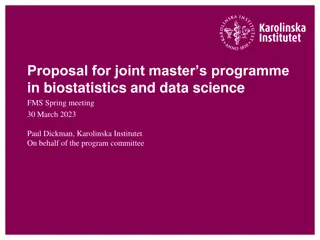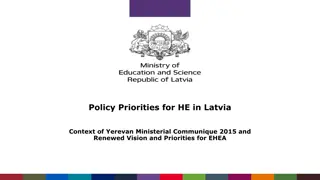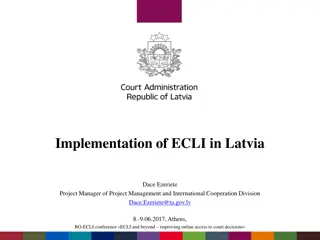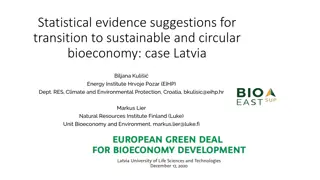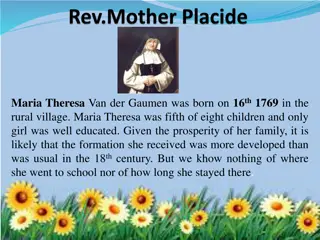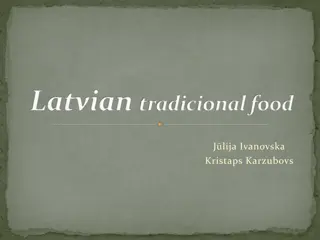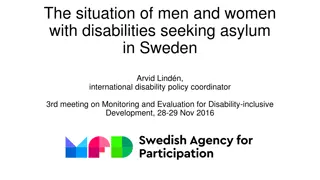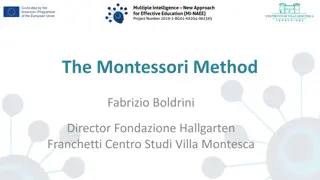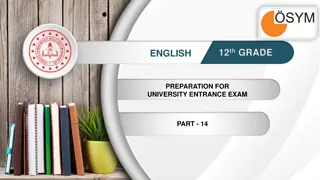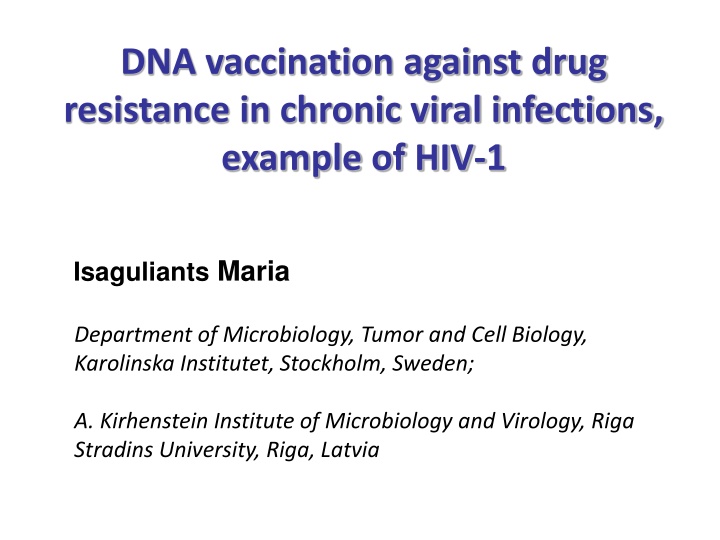
DNA Vaccination Against Drug Resistance in Chronic Viral Infections
Explore the research on using DNA vaccination to combat drug resistance in chronic viral infections, focusing on HIV-1. The study aims to prevent or hinder drug resistance development in HIV infection through therapeutic vaccination parallel to Highly Active Antiretroviral Therapy (HAART). Tasks include selection of antigens, genetic background design, and efficient DNA delivery protocols for preclinical trials. The design of immunotherapeutics involves choosing antigens like HIV enzymes and the vaccine vehicle of naked DNA plasmid backbone with HIV enzyme genes. This study presents a novel approach to exert non-drug pressure on HIV-1 to reduce its resistance development capacity.
Download Presentation

Please find below an Image/Link to download the presentation.
The content on the website is provided AS IS for your information and personal use only. It may not be sold, licensed, or shared on other websites without obtaining consent from the author. If you encounter any issues during the download, it is possible that the publisher has removed the file from their server.
You are allowed to download the files provided on this website for personal or commercial use, subject to the condition that they are used lawfully. All files are the property of their respective owners.
The content on the website is provided AS IS for your information and personal use only. It may not be sold, licensed, or shared on other websites without obtaining consent from the author.
E N D
Presentation Transcript
DNA vaccination against drug resistance in chronic viral infections, example of HIV-1 Isaguliants Maria Department of Microbiology, Tumor and Cell Biology, Karolinska Institutet, Stockholm, Sweden; A. Kirhenstein Institute of Microbiology and Virology, Riga Stradins University, Riga, Latvia
BACKGROUND Highly Active Antiretroviral Therapy (HAART) dramatic change Death from AIDS-related diseases reduced significantly How long clinical benefit will last? the emergence of multiple drug-resistant viral strains (drHIV) primary infections with drHIV failures on HAART regimens Immune response limits HIV-1 replication. Elite controllers! Under HAART no antigen stimulation - loss of anti-HIV immune response Urgent task to exert an additonal non-drug pressure on HIV-1 to reduce its capacity to develop resistance CREATE A BOTTLE NECK EFFECT CONCEPT - complement HAART with an immune pressure!
AIM Prevent or hinder development of drug resistance in HIV-infection by therapeutic vaccination preceding or parallel to HAART Immune prevention of primary DR mutations to hamper the whole process of drug resistance development
TASKS: Selection of antigens responsible for resistance HIV enzymes, gp41. Selection of genetic background HIV1 FSU-A Consensus approach to design of antigens Genetic engineering of plasmid vectors Modification of antigens by introduction of primary drug resistance mutations Efficient protocols for DNA delivery for preclinical trials Preclinical trials, also on the background of treatment with antiretroviral drugs
DESIGN OF IMMUNOTHERAPEUTICALS Choice of components Antigens involved in HIV resistance primarily HIV ENZYMES Design principles: HIV-1 subtype A prevalent in Russia and FSU consensus sequence Block appearance of early mutations hamper the whole process primary DR mutations Introduce mutations abrogated enzymatic activity enzyme inactivation for safety
DESIGN OF IMMUNOTHERAPEUTICALS Choice of vaccine vehicle - naked DNA PLASMID BACKBONE ENZYME GENE pVax 1 (Invitrogen) HIV ENZYME GENES - Consensus HIV-1 subtype A - Codon-optimized to increase expression MULTI-GENE SET GENERATED: RTPRIN-A - Reverse Transcriptase; - Protease; - Integrase HIV subtype A
DESIGN OF IMMUNOTHERAPEUTICALS: example of protease HIV-1 Protease Cleaves Gag and Pol polyproteins into mature forms Major target of antiretroviral therapy Protease inhibitors (PIs) bind active site Long-term effectiveness limited due rapid viral evolution, leading to proteases with drastically lower affinity to the drugs 20/03/2025 Louis et al. 2011 Slide by Athina Kilpel inen
DESIGN OF IMMUNOTHERAPEUTICALS: sequence selection HIV-1 FSU-A Protease amino acid sequences from treatment-na ve patients were selected from databases (Los Alamos, Genbank). Sequence set 1 (n=218) Sequence set 2 (n=40) AZ 18% MD 2% KZ 15% UA 25% ES 1% UZ 20% GE 14% UA 58% RU 40% BL 1% KZ 1% UZ 3% RU 2% Athina Kilpel inen, HOV Nordic 2014 Athina Kilpel inen
DESIGN OF IMMUNOTHERAPEUTICALS: creation of consensus Consensus protein sequence Consensus sequences built on 1996-2003 and 2000-2011 selections were 100% identical Consensus adequately represent FSU-A PR in (some) years to come PR_A consensus PR_B consensus PR_B (HXB2) Athina Kilpel inen
DESIGN OF IMMUNOTHERAPEUTICALS: selection of DR mutations Selection of drug resistance mutations: A set of primary DR mutations 46I, 54V and 82 45 40 35 Fold resistance 30 25 20 15 10 5 0 NFV (n=22) SQV (n=22) IDV (n=20) RTV (n=40) FPV (n=18) LPV (n=16) ATV (n=7) http://hivdb.stanford.edu/cgi-bin/PositionPhenoSummary.cgi
Immunogens: In vitro, cell line tests PR_A and PR_Ai are expressed in oocytes of X laevis pVax1 PR_A PR_B PR_Ai PR_Bi 6.5 5.5 4.5 Intensity E xp ressio n relative to P R _B 1.5 3.5 1.0 2.5 1.5 0.5 0.5 12 17 0.0 P R _A i P R _B i P R _B P R _A Distance (mm) A Kilpel inen
Immunogens: Evolution of RT-based immunogens Modification of HIV-1 reverse transcriptase gene Modification Codon Optimization - + Enzyme inactivation - - Drug Resistance - - RT wt RT wt opt RT wt opt-in + + - RT 1.14 - - + RT 1.14 opt + - + RT 1.14 opt-in + + +
PRECLINICAL PERFORMANCE OF VACCINE COMPONENTS DNA-immunization protocol GENE Injection + Electroporation DAY -4 DAY 21 DAY 0 COLLECTION OF HYPERIMMUNE SAMPLES (SERA, splenocytes) COLLECTION OF PREIMMUNE SAMPLES SAMPLE ANALYSIS: ELISA, ELISpot, FLUOROSpot, FACS
DELIVERY Optimized protocol of vaccine delivery Needle injection - most commonly used - 1000-times enhanced gene delivery & expression Electroporation over the injection site - 100-times enhanced immune response - widely used in clinical trials
DELIVERY Optimization of gene delivery vaccine inoculation Biojector (delivery by gas pressure) 29G needles OR Microneedles http://www.vaccinetech.co.uk/images/resources/micronjet_20090619.jpg Optimization of gene delivery - electroporation Petkov SP, Heuts F, Krotova OA, Kilpelainen A, Engstr m G, Starodubova ES, Isaguliants MG. Hum Vaccin Immunother. 2013 Jul 3;9(10). Evaluation of immunogen delivery by DNA immunization using non-invasive bioluminescence imaging
DELIVERY IN PRECLINCALS Optimization of plasmid delivery Immunization of BALB/c mice with viral DNA mixed with DNA encoding Luciferase followed by in vivo imaging 2D- and 3D-imaging quantifies gene delivery with each injection Stefan Petkov
Immunogenicity of candidate immunotherapeuticals in mice Inactive consensus protease of HIV FSU-A was highly immunogenic in BALB/c mice PR-specific secretion of IFN- /IL-2 by splenocytes of PR_Ai gene immunized mice. DR variants of PR_Ai are under trial IFN- mln splenocytes IL-2mln splenocytes Athina Kilpel inen, HOV Nordic 2014
PRECLINICAL PERFORMANCE OF VACCINE COMPONENTS Immune response in BALB/C mice after one immunization T-cell response Dual IFN-g/IL-2 production (Fluorospot) Humoral response IgG and IgA titers (ELISA) 100000 500 Net sfu/mln splenocytes 400 10000 Ab titer 300 IgG IgA 200 1000 100 0 100 RT PR IN RT PR IN Starodubova E. Et al Mol Imaging 2012; Isaguliants M et al, Human Vaccines & Immunotherapeuticals 2013; Halleng rd D et al, Vaccine 2011; Krotova OA et al, PLoS One 2013
SUMMARY ON WHAT WE OFFER TO DEVELOP FOR THERAPEUTIC USE PROTOTYPE VACCINE COMPONENTS Plasmids encoding HIV enzymes reverse transcriptase, protease and integrase that are: contain primary mutations of drug resistance; no enzymatic activity; consensus sequence of subtype A and B (region specific). Plasmids tested for expression in cell culture and mouse tissues DELIVERY METHOD Effective protocols of needle injections followed by electroporation STRONG IMMUNOGENIC PERFORMANCE IN PRECLINICALS All components induce strong polyfunctional immune response in rodents; Rabbit experiments are on-going.
SUMMARY ON WHAT WE OFFER TO DEVELOP FOR THERAPEUTIC USE OUTLINE FOR A CLINICAL TRIAL: Standard in therapeutic HIV-1 vaccine trials: Immunization Drug treatment off Measure viral loads Structured Therapy Interruption (STI) can be harmful! We suggest: No unsafe procedures Therapeutic immunization + HAART, NO STIs Measure frequency of drug-resistance conferring mutations
ACKNOWLEDGMENTS Engelhardt Institute of Molecular biology, Moscow, Russia Ivanovsky Institute of Virology, Moscow, Russia Karolinska Institutet, Stockholm, Sweden Stefan Petkov Athina Kilpel inen David Halleng rd Per Warholm Britta Wahren Elizaveta Starodubova Anastasia Latanova Vadim L Karpov Yulia Kuzmenko Olga Krotova Oleg Latyshev Olesya Eliseeva Grants of the Swedish Research Fund 2012-2015; Thematic partnership grant of the Swedish Institute 2013-2016; EU project BALTINFECT 2013- 2016; Russian Fund for Basic Research 2013-2015.



